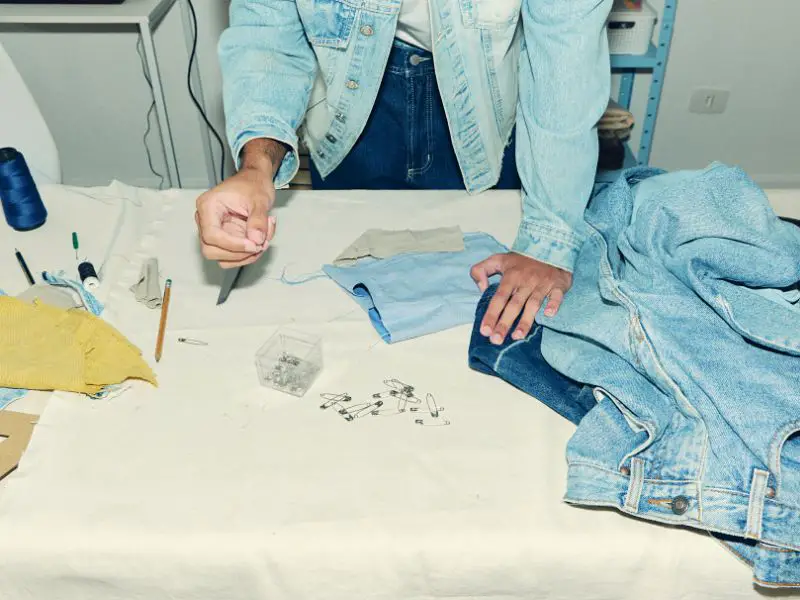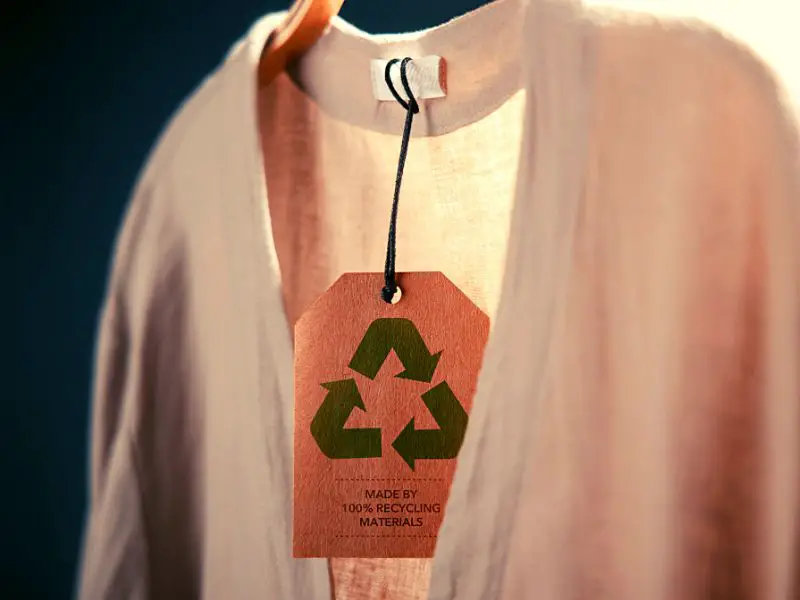With fast fashion accounting for around 10% of global greenhouse gas emissions, it’s evident that something needs to be done to address the industry’s rising environmental effects. Fast fashion encourages us to buy more items, many of which will break apart within a few months, just to follow trends.
As consumers, we wield a strong influence over how our money is spent. By supporting firms that embrace sustainable business methods and fair labor standards, you can help drive demand for a more positive path for the fashion industry.
Many of you know already that sustainable fashion can be prohibitively pricey, which can be off-putting to some. Let’s take a closer look at why it’s expensive, what to look for, and what sustainable clothing brands yet reasonably priced you should consider.
Why is Sustainable Clothing Expensive?
Seeing the price tag of sustainable clothing is off-putting. The first buy I had was a 40$ shirt, which felt a lot more expensive because I’m used to fast fashion clothing. There are a couple of reasons the price is higher, and if you think about it, the higher price is for a good cause.

Sustainable Materials
Sustainable clothing is typically composed of natural or semi-natural materials such as lyocell. Even within that, natural fibers must be farmed organically, without pesticides, while minimizing wastewater and proper handling of disposal. Moreover, sustainably sourcing raw materials and promoting a circular economy is costly, affecting the final product’s pricing.
Fair Wages for Labor
Sadly, fast fashion employs a large number of children and underpaid labor. Too frequently, fast fashion contributes to sweatshop conditions, which is unacceptable for anybody manufacturing sustainable clothing. Ethical fashion firms believe in giving a decent wage to everyone involved in the supply chain, from farmers to seamstresses.
High Quality Is an Investment
Sustainable fashion is intended to be worn repeatedly, not just in a single six-month cycle. As a result, great care is taken in building each garment to ensure that it will stand the test of time. This means that the item will take longer to make and use higher-quality materials. The extra expenses of this manufacturing method are typically passed on to the end-user or consumers. All of these factors influence pricing. That’s why you won’t find a $5 ethically produced t-shirt.
What to Look For in Buying Sustainable Clothing?
1. Check the Material
Purchasing clothing made of natural or sustainable semi-synthetic fiber is the first step in shopping sustainably. Hemp, linen, and organic cotton are all excellent choices. Avoid polyester and nylon, both of which are petroleum-based. If you’re looking for clothing composed of these materials, seek recycled polyester or nylon. This one conscious choice has the potential to make a significant difference! Examine the dyes used; natural dyes are usually healthier for the environment.

2. Support Local and Beware of Greenwashing
Many major brands now have signs indicating that their clothing is environmentally friendly. While there’s a shift in this direction, it is not always like it in the backends. Before making a purchase, inspect the garment labels and materials. Shopping for locally created and produced clothes is always a plus when possible. Please don’t hesitate to contact a company through email and inquire about their eco-friendly products, sustainable efforts, or fair trade policies. Ethical firms committed to the greater good would be delighted to answer your questions and be grateful that you took the time to do so.

5 Best Sustainable Clothing Brands
It is not always easy to find ethical clothing. A few brands have high standards for the ethics and quality of their clothing. These fashion brands are making waves of change with their active approach to social consciousness and fair trade. Here are popular brands you can count on for an assortment of eco-friendly, body-positive clothes and garments.
1. Toad & Co
Toad & Co is not just in the clothing industry but also in the business of change. They’re attempting to clean up the filthy clothing business.
This environmentally friendly outdoor brand offers reasonably priced shirts, jeans, t-shirts, sweaters, sustainable rain jackets, undergarments, accessories, skirts, dresses, and other items for men and women.
Materials
Toad&Co. commonly use organic cotton, hemp, recycled polyester, RWS-certified non-mulesed wool, TENCEL lyocell, and Lenzing Modal.
They avoid traditional cotton, acrylic, rayon/viscose, bamboo, and silk. However, you will most certainly notice polyester or a little bit of elastane in some items for a little stretch (but both are easy to avoid should you want something with 100 percent eco-materials).
Supply Chain & Labor Practices
Toad&Co employs fair labor standards and maintains safe working conditions in its factories. They follow a stringent Code of Conduct and arrange yearly factory visits to guarantee their products are created with integrity.
Some production takes place in their California-based plant, which teaches and employs persons with disabilities in collaboration with Planet Access Company.
Green Business Practices
This brand has a long list of prohibited substances, ensuring that no harmful compounds wind up damaging the environment or your wardrobe. As a result, certain items have received bluesign® and OEKO-TEX certifications.
Charity
Not only do they provide solid jobs for over 70 persons with disabilities at their California plant, but they also travel together on occasion through the Search for Adventure program. Apart from that, Toad & Co. is a consistent supporter of various local non-profits.
2. Mate the Label
At the heart of MATE THE Label ethos is conscious consumption. MATE’s levitated essentials are fashioned from organic, sustainable textiles; all manufactured within a 10-mile radius of their headquarters in downtown Los Angeles
Materials
You’ll discover organic cotton (in various fabric types), TENCEL lyocell, linen, hemp, and some conventional cotton (until they can find an organic alternative). For colors, they use low-impact dyes.
Supply Chain & Labor Practices
MATE collaborates with cotton producers in Maharashtra, India, who grow organic and conventional cotton. The linen is sourced from China, while the TENCEL is sourced from the Austrian company Lenzing. They utilize the “v” localized supply chains, and their factories adhere to fair trade standards and Californian labor regulations.
Green Business Practices
They have an environmentally friendly office with bamboo workstations, organic tampons, environmentally friendly toilet paper, and in-house composting.
They are also developing a method to take old MATE products and transform them into new ones!
Community
MATE offers a discount to essential workers.
3. Pact
Pact is a textile manufacturing brand that provides sustainable and ethical fashion by designing trendy clothes using organic fibers and fair trade manufacturers. Pact employs organic cotton in a transparent supply chain that benefits farmers and employees the most.
Materials
Pact’s OG material is organic cotton. They offer a line for men and women entirely made of GOTS-certified organic cotton.
Supply Chain & Labor Practices
Pact collaborates with farmers and manufacturers in India, where all of the company’s organic cotton is sourced and processed in a fair trade facility.
Green Business Practices
Pact supports water and energy conservation, minimizing fabric waste, and using recyclable/compostable packaging. Additionally, Pact offers consumers the option to offset their shipping emissions.
Community Giving
Pact recycles its shipping materials to give back to the community. When you purchase your new Pact item, their box can be filled with old clothes (any brand) that you no longer want.
4. Able
Able has expanded its ability to empower women by developing product categories and impact areas. Able dresses women from head to toe in carefully crafted items that express who she truly is: creative, strong, important, and deserving. ABLE’s high-quality leather items, handcrafted jewelry, clothes, jeans, and shoes are more than simply wardrobe pieces; they represent good investments in women worldwide.
Materials
With a strong emphasis on ethical manufacturing, materials might sometimes take a backseat.
While it is possible to obtain clothing manufactured from natural and sustainable textiles (such as organic cotton, cotton, and modal), you will also come across certain materials that aren’t necessarily the favorites (like lamb leather, polyester, spandex, and viscose).
Supply Chain and Labor Practices
This is where exactly ABLE shines. In 2018, they permanently changed the fashion industry by sharing their lowest-paid employees’ salaries with consumers and the rest of the globe. Essentially, it serves as a role model for another eco ethos to follow by founding the Lowest Wage Challenge (in collaboration with Nisolo, whose eco-friendly boots are the best)
Green Business Practices
While they currently use plastic poly bags, they hope to transition to reusable cloth bags soon.
5. Organic Basics
This Danish brand mixes some of the highest-quality fabrics with ethical production techniques easy on consumers’ budgets. They began their journey into a sustainable design with men’s underwear but have since expanded to include men’s and women’s essential apparel needs: from socks to sustainable gloves, ethical sportswear to ethical underwear, and everything in between.
Materials
Organic Basics uses organic cotton from the Aegean Sea region. In addition, you’ll also find organic cotton, recycled nylon, TENCEL lyocell, recycled wool, and recycled cashmere in the Organic Basics product descriptions.
Supply Chain and Labor Practices
Organic Basics collaborates with factories around Europe and exclusively works with the “good guys.” This ensures that their items are not manufactured using forced or child labor and that their workers have a safe working environment and a fair, livable salary.
Green Business Practices
Each Organic Basics product description tells you how your Organic Basics item will fit and how it is a good fit for the environment. Every clothing features an impact index, which shows how many emissions and chemicals were avoided and how much water was saved by the garment. The company’s annual impact report also summarizes the organization’s overall performance.
Community & Charity
The Organic Basics Fund is accessible to European groups addressing some of the most challenging environmental and social issues. Every year, a few applications are chosen to receive assistance.
Author’s Note
I hope this article has helped you understand the importance of sustainable fashion. Sustainable fashion looks and performs differently than conventional garments, but it offers several advantages to people who purchase it. Purchasing from eco-friendly brands like Organic Basics, Able and Organic Pact will help reduce our carbon footprint and ensure that we make ethical decisions every day with what we wear.
Check out these articles and learn more about sustainable and eco-friendly materials you can use at home and in the workplace.
- Vegan Leather Boots: A Complete Guide to This Cause-Driven Footwear
- The Essential Guide To Botanical Perfumes
- Natural Skincare Treatments for a Healthy Glowing Skin
- 7 Natural Shampoo Alternatives for Beautiful and Healthy Hair
Feel free to share this article on your social media accounts. In this way, you can help others choose sustainable and ethical fashion.


1 thought on “Top 5 Best Affordable and Sustainable Clothing Brands”